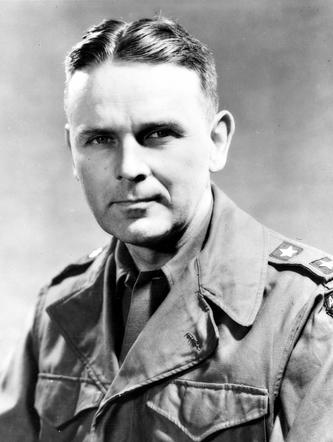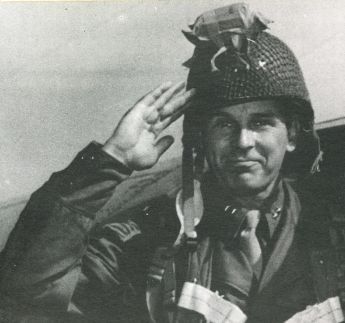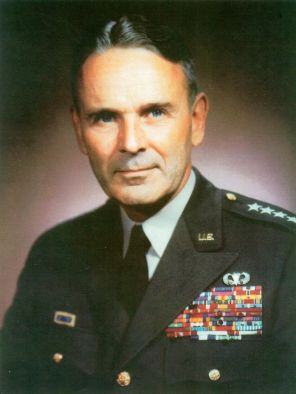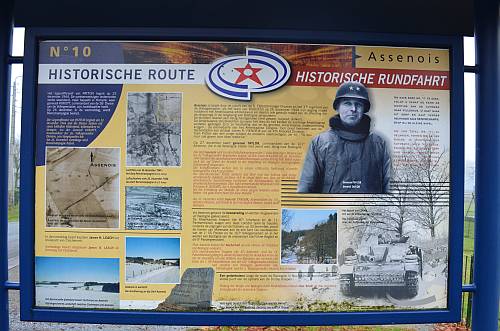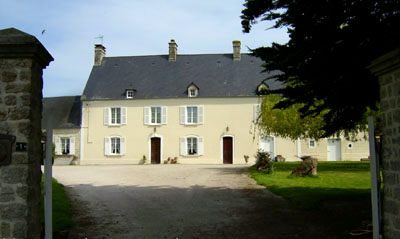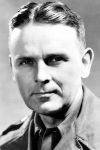Introduction
Major General Taylor had a long career in the military. During World War II he participated in the fighting in Sicily, in Italy, Normandy, The Netherlands, the Ardennes and Germany. During the campaign in Northern Europe Taylor commanded the 101st Airborne Division, but when this division peaked in combat, during the defense of Bastogne, Taylor was on leave. When discussing the role of Major General Taylor during World War II, it is often about his absence during this battle.
Taylor was nicknamed "Mr. Attack". This nickname was probably introduced by Colonel Robert F. Sink, regimental commander of the 506th Parachute Infantry Regiment, 101st Airborne Division, during the last part of the Battle of the Bulge.
Before the war
Maxwell Davenport Taylor was born on August 26, 1901, in Keytesville, Missouri. He was raised a Protestant. His father was a lawyer and he also liked to see Taylor become a lawyer. However, Taylor wanted to join the army, his father was not very happy about this. Despite this, Taylor nevertheless enlisted. In 1922 Taylor graduated from the United States Military Academy at the age of 21 as a 2nd Lieutenant. After graduation, Taylor held a role in the Army Corps of Engineers. He served with the 3rd Engineers Regiment in Hawaii from 1923 to 1926. In 1925 he married Lydia Gardner Happer. Taylor was transferred to the Field Artillery in 1926. He served with the 10th Field Artillery Battery for the next two years. During his time with this unit he was promoted to 1st Lieutenant, in February 1927. Between 1927 and 1932 Taylor worked at the West Point Military Academy. Here he taught French and Spanish. Taylor then went to the Field Artillery School, graduating in 1933 and graduating from Command and General Staff School in Fort Leavenworth, Kansas, in 1935. In August of that year Taylor was promoted to Captain. After graduating from the US Army War College in 1940, Taylor was promoted to Major.
During the war
Meanwhile World War II had started, but Taylor did not take part in the action yet. He served in the War Plans Division. Here Taylor was involved in planning the Allied landings in Sicily and Italy. He also commanded the 12th Field Artillery Battalion in the period 1940-1941. Taylor was temporarily promoted to Lieutenant Colonel in December 1941, to Colonel in February 1942, and to Brigadier General in December 1942. In the same year, Taylor commanded the artillery of the 82nd Airborne Division in Sicily and Italy. On July 9, 1943, the 82nd Airborne Division jumped during the invasion of Sicily. However, the airborne landing was very chaotic. The paratroopers prevented the Hermann-Goering Panzer Division from making contact with the Americans who had landed at Gela and Licata and so the ground troops could advance further.
In mid-August, Sicily was in Allied hands. Sicily was the springboard to the Italian mainland for the Allies. The King of Italy, meanwhile, had fired Mussolini, and the Italian government polled the Allies for peace. Prior to the landings in Italy, Taylor secretly parachuted into Rome. In Rome, Taylor negotiated with the Italian government. After the Allies landed in Italy and established a bridgehead at Salerno, the Germans counterattacked. The 82nd Airborne Division was dropped to strengthen the bridgehead. The artillery played an important role in the rescue of the bridgehead. The division's artillery was critical in the recapture of Altavilla on September 16.
Taylor stayed with the 82nd Airborne Division until 1944. He was temporarily promoted to Major General in May 1944 and was given command of the 101st Airborne Division, when Major General Bill Lee was forced to resign due to a heart attack. With this division he jumped over Normandy on June 6, 1944 during Operation Overlord. Taylor's division had to clear the roads leading inland from Utah Beach for the troops that landed from the sea. After D-Day the 101st Airborne Division was involved in the battle for Carentan.
On September 17, 1944, Taylor and his division jumped over The Netherlands. The 101st Airborne Division was part of the 1st Allied Airborne Army and participated in Operation Market Garden. Field Marshal Bernard Montgomery had devised a plan to conquer all bridges on the route to Germany through The Netherlands. Taylor's division was dropped near Eindhoven to capture the bridges there. Immediately after landing, Taylor split up his troops to capture the various bridges in the area. However, the bridge at Son was blown up by the Germans, causing Market Garden to be delayed early on. After the ground forces passed, the division had to keep the corridor open. The Germans carried out some fierce attacks on the corridor, but Taylor had organized the defense so well that the division could hold its own. After Market Garden, Taylor's division took over defensive positions from the British until the division itself was relieved.
On Saturday December 16, the Germans attacked in the Ardennes. The 101st Airborne Division was sent to Bastogne by General Dwight Eisenhower to defend the city. However, Taylor was on leave in the United States and had temporarily transferred command to Brigadier General Anthony McAuliffe. The 101st Airborne Division survived Bastogne and became famous overnight, as did the temporary commander McAuliffe for his famous answer - Nuts! - on the German demand to surrender. When General George Patton broke through the encirclement of Bastogne with his Third Army, Taylor re-assumed command of his division. Under the leadership of Taylor, the 101st Airborne Division took part in the Allied counterattack in the Ardennes. Here Taylor got his nickname "Mr. Attack". Among the troops the idea was current that Taylor wanted to make up for missing the action at Bastogne by showing that his division could push the Germans back from the Ardennes. For Taylor it was of course disappointing that he had to follow the siege of Bastogne from the sidelines. But he said: "I always comfort myself thinking that it provided a great soldier and a very good friend, Anthony McAuliffe, the opportunity to become an important person in this world."
After the Germans were pushed out of the Ardennes, the German resistance seemed to be largely broken. Taylor moved into Germany with his division and was there at the time of the German surrender on May 5th, 1945.
After the war

Portrait of Taylor, at that moment chairman of the Joints Chiefs of Staff. Source: United States Army.
In 1953, the Korean War broke out. Taylor commanded the troops of the 8th Army during the final operations of the Korean War. He then coordinated a program of support for the Korean armed forces. He was given command of the United States' forces in the Far East. Taylor retired in 1959, but in 1961 President Kennedy brought Taylor back into the army. At Kennedy's suggestion, he became chairman of the Joints Chiefs of Staff from 1962 to 1964. In this position he had to forge the various parts of the army into a well-organized entity. Taylor also served in this position under President Johnson until he retired for the second time in 1964, this time definitively. Taylor was ambassador to South Vietnam in the period 1964-1965. From 1966 to 1969, he was the chairman of an institute that did analyses for the Ministery of Defense.
Taylor died in Washington, D.C. on April 19, 1987, at the age of 85. Of these 85 years, Taylor had spent 41 in the military. Taylor is buried at Arlington National Cemetery.
Definitielijst
- D-Day
- The day of the long awaited invasion of western Europe in Normandy, France, 6 June 1944. After a long campaign of deception the allies attacked the coast of Normandy on five beaches to begin their march on Nazi Germany. Often explained as Decision Day, though this is entirely correct. The D stands for Day as generally used in military language. In this case it means an operation beginning on day D at hour H. Hence “Jour J“ in French.
- Infantry
- Foot soldiers of a given army.
- invasion
- Armed incursion.
- Marshal
- Highest military rank, Army commander.
- mid
- Military intelligence service.
- paratroopers
- Airborne Division. Military specialized in parachute landings.
- Regiment
- Part of a division. A division divided into a number of regiments. In the army traditionally the name of the major organised unit of one type of weapon.
- resistance
- Resistance against the enemy. Often also with armed resources.
Prior to the war
Maxwell Davenport Taylor was born on August 26, 1901, in Keytesville, Missouri. He was raised a Protestant. His father was a lawyer and he also liked to see Taylor become a lawyer. However, Taylor wanted to join the army, his father was not very happy about this. Despite this, Taylor nevertheless enlisted. In 1922 Taylor graduated from the United States Military Academy at the age of 21 as a 2nd Lieutenant. After graduation, Taylor held a role in the Army Corps of Engineers. He served with the 3rd Engineers Regiment in Hawaii from 1923 to 1926. In 1925 he married Lydia Gardner Happer. Taylor was transferred to the Field Artillery in 1926. He served with the 10th Field Artillery Battery for the next two years. During his time with this unit he was promoted to 1st Lieutenant, in February 1927. Between 1927 and 1932 Taylor worked at the West Point Military Academy. Here he taught French and Spanish. Taylor then went to the Field Artillery School, graduating in 1933 and graduating from Command and General Staff School in Fort Leavenworth, Kansas, in 1935. In August of that year Taylor was promoted to Captain. After graduating from the US Army War College in 1940, Taylor was promoted to Major.
Definitielijst
- Regiment
- Part of a division. A division divided into a number of regiments. In the army traditionally the name of the major organised unit of one type of weapon.
During the war
Meanwhile World War II had started, but Taylor did not take part in the action yet. He served in the War Plans Division. Here Taylor was involved in planning the Allied landings in Sicily and Italy. He also commanded the 12th Field Artillery Battalion in the period 1940-1941. Taylor was temporarily promoted to Lieutenant Colonel in December 1941, to Colonel in February 1942, and to Brigadier General in December 1942. In the same year, Taylor commanded the artillery of the 82nd Airborne Division in Sicily and Italy. On July 9, 1943, the 82nd Airborne Division jumped during the invasion of Sicily. However, the airborne landing was very chaotic. The paratroopers prevented the Hermann-Goering Panzer Division from making contact with the Americans who had landed at Gela and Licata and so the ground troops could advance further.
In mid-August, Sicily was in Allied hands. Sicily was the springboard to the Italian mainland for the Allies. The King of Italy, meanwhile, had fired Mussolini, and the Italian government polled the Allies for peace. Prior to the landings in Italy, Taylor secretly parachuted into Rome. In Rome, Taylor negotiated with the Italian government. After the Allies landed in Italy and established a bridgehead at Salerno, the Germans counterattacked. The 82nd Airborne Division was dropped to strengthen the bridgehead. The artillery played an important role in the rescue of the bridgehead. The division's artillery was critical in the recapture of Altavilla on September 16.
Taylor stayed with the 82nd Airborne Division until 1944. He was temporarily promoted to Major General in May 1944 and was given command of the 101st Airborne Division, when Major General Bill Lee was forced to resign due to a heart attack. With this division he jumped over Normandy on June 6, 1944 during Operation Overlord. Taylor's division had to clear the roads leading inland from Utah Beach for the troops that landed from the sea. After D-Day the 101st Airborne Division was involved in the battle for Carentan.
On September 17, 1944, Taylor and his division jumped over The Netherlands. The 101st Airborne Division was part of the 1st Allied Airborne Army and participated in Operation Market Garden. Field Marshal Bernard Montgomery had devised a plan to conquer all bridges on the route to Germany through The Netherlands. Taylor's division was dropped near Eindhoven to capture the bridges there. Immediately after landing, Taylor split up his troops to capture the various bridges in the area. However, the bridge at Son was blown up by the Germans, causing Market Garden to be delayed early on. After the ground forces passed, the division had to keep the corridor open. The Germans carried out some fierce attacks on the corridor, but Taylor had organized the defense so well that the division could hold its own. After Market Garden, Taylor's division took over defensive positions from the British until the division itself was relieved.
On Saturday December 16, the Germans attacked in the Ardennes. The 101st Airborne Division was sent to Bastogne by General Dwight Eisenhower to defend the city. However, Taylor was on leave in the United States and had temporarily transferred command to Brigadier General Anthony McAuliffe. The 101st Airborne Division survived Bastogne and became famous overnight, as did the temporary commander McAuliffe for his famous answer - Nuts! - on the German demand to surrender. When General George Patton broke through the encirclement of Bastogne with his Third Army, Taylor re-assumed command of his division. Under the leadership of Taylor, the 101st Airborne Division took part in the Allied counterattack in the Ardennes. Here Taylor got his nickname "Mr. Attack". Among the troops the idea was current that Taylor wanted to make up for missing the action at Bastogne by showing that his division could push the Germans back from the Ardennes. For Taylor it was of course disappointing that he had to follow the siege of Bastogne from the sidelines. But he said: "I always comfort myself thinking that it provided a great soldier and a very good friend, Anthony McAuliffe, the opportunity to become an important person in this world."
After the Germans were pushed out of the Ardennes, the German resistance seemed to be largely broken. Taylor moved into Germany with his division and was there at the time of the German surrender on May 5th, 1945.
Definitielijst
- D-Day
- The day of the long awaited invasion of western Europe in Normandy, France, 6 June 1944. After a long campaign of deception the allies attacked the coast of Normandy on five beaches to begin their march on Nazi Germany. Often explained as Decision Day, though this is entirely correct. The D stands for Day as generally used in military language. In this case it means an operation beginning on day D at hour H. Hence “Jour J“ in French.
- invasion
- Armed incursion.
- Marshal
- Highest military rank, Army commander.
- mid
- Military intelligence service.
- paratroopers
- Airborne Division. Military specialized in parachute landings.
- resistance
- Resistance against the enemy. Often also with armed resources.
After the war
In 1953, the Korean War broke out. Taylor commanded the troops of the 8th Army during the final operations of the Korean War. He then coordinated a program of support for the Korean armed forces. He was given command of the United States' forces in the Far East. Taylor retired in 1959, but in 1961 President Kennedy brought Taylor back into the army. At Kennedy's suggestion, he became chairman of the Joints Chiefs of Staff from 1962 to 1964. In this position he had to forge the various parts of the army into a well-organized entity. Taylor also served in this position under President Johnson until he retired for the second time in 1964, this time definitively. Taylor was ambassador to South Vietnam in the period 1964-1965. From 1966 to 1969, he was the chairman of an institute that did analyses for the Ministery of Defense.
Taylor died in Washington, D.C. on April 19, 1987, at the age of 85. Of these 85 years, Taylor had spent 41 in the military. Taylor is buried at Arlington National Cemetery.

Portrait of Taylor, at that moment chairman of the Joints Chiefs of Staff. Source: United States Army.
Information
- Article by:
- Pieter Schlebaum
- Translated by:
- Francois Dumas
- Published on:
- 19-01-2025
- Feedback?
- Send it!
Related sights
Sources
- - MANION, A. & MCAULIFFE, T., Conversations between Colonel Manion and General Taylor
, US Army Military History Research Collection, Carlisle, 1972-1973. - - Arlington National Cemetery Website
- - Generals.dk
- - WW2-airborne.us (1)
- - WW2-airborne.us (2)
